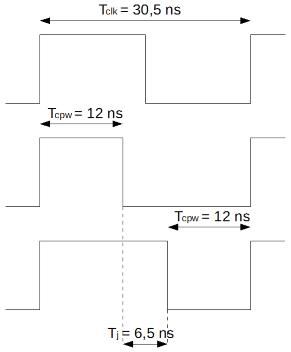Hi,
For the ADS1278-HT, which is a sigma-delta ADC, oversampled digitally filtered and decimated output, assuming high speed mode and fclk=32.768 MHz that means fmod=fs=fclk/4=8.192 MHz.
Looking at the datasheet, for full operating temperature range, pg 13 gives me SNR = 96 dB (@210 ºC), does this value apply for the BWNyquist up to fs/2?
So that, if my input signal BWsignal = 60 kHz I should get a process gain 10*log10(8.192*10^6/(2*60*10^3)) = 18.34 dB improvement from oversampling over the 96 dB spec?
The SNR = 96 dB from the datasheet accounts for quantization, thermal and clock jitter. Given the quantization and thermal are ADC's but jitter is from the external clock, how much is SNR from the clock used in the datasheet tests, so that I can take that parcel out and account for my own clock jitter? Does this even make sense?
After having answers for the previous questions, am I safe to calculate SINAD with the corrected SNR and THD as the
SINAD=-10*log10(10^(-SNR/10)+10^(-THD/10))
or do I have to make a correction (how?) because THD is not from a full scale input but -0.5 dBFS instead?
And then finally get ENOBADC from the SINAD. Phew! :-)
By the way, anybody knows of a good high-temp (200 ºC) clock for this ADS1278-HT ADC?
Sorry for all the questions, but I really need to clear this...
Thank you all and kind regards,
Rui



